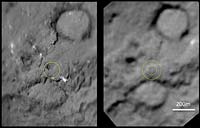|
COMETS EARTH JUPITER KUIPER BELT MARS MERCURY METEORITES NEPTUNE OORT CLOUD PLUTO SATURN SOLAR SYSTEM SPACE SUN URANUS VENUS ORDER PRINTS
PHOTO CATEGORIES SCIENCEVIEWS AMERICAN INDIAN AMPHIBIANS BIRDS BUGS FINE ART FOSSILS THE ISLANDS HISTORICAL PHOTOS MAMMALS OTHER PARKS PLANTS RELIGIOUS REPTILES SCIENCEVIEWS PRINTS
|
Related Documents
Download Options
This pair of images shows the area affected by the impactor released by NASA's Deep Impact spacecraft in July 2005. On the left, the image from Deep Impact shows a dark mound about 50 meters (160 feet) in size. It is inside a yellow circle that shows the area hit by the impactor released by Deep Impact. The image on the right, newly obtained by NASA's Stardust spacecraft, shows the impactor erased that dark mound and flattened the area. The outer circle annotated on the right-hand image shows the outer rim of the crater and the inner circle shows the crater floor. The crater is estimated to be 150 meters (500 feet) in diameter. Scientists are still working to estimate the depth of the crater, but preliminary analysis shows that it is shallow. The larger craters on the comet are about 300 meters (1,000 feet) across. Stardust-NExT is a low-cost mission that will expand the investigation of comet Tempel 1 initiated by NASA's Deep Impact spacecraft. JPL, a division of the California Institute of Technology in Pasadena, manages Stardust-NExT for the NASA Science Mission Directorate, Washington, D.C. Joe Veverka of Cornell University, Ithaca, N.Y., is the mission's principal investigator. Lockheed Martin Space Systems, Denver, built the spacecraft and manages day-to-day mission operations. |
